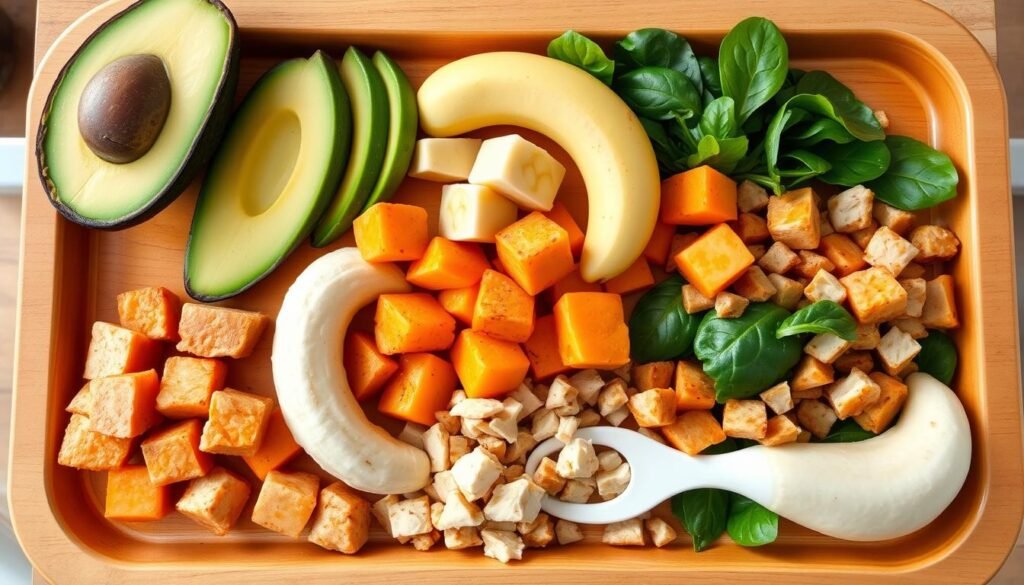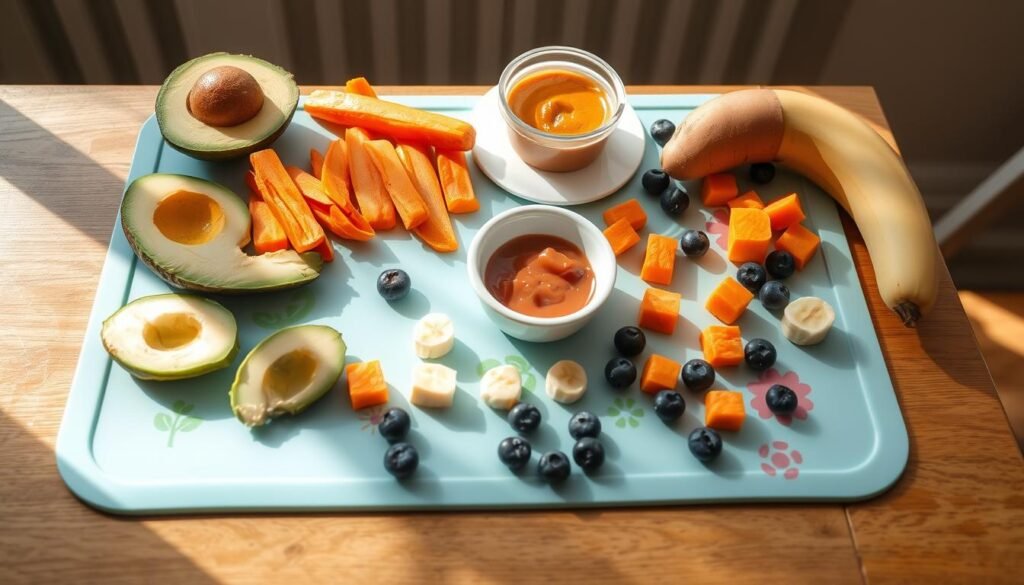Introducing solid foods to your baby can be both thrilling and nerve-wracking. Baby-led weaning (BLW) is a special way that lets your child take charge during this big change1. It’s perfect for babies 6 months and older, letting them try different tastes and textures at their own speed1.
Unlike other ways of starting solids, BLW lets your baby eat whole, soft foods by themselves2. This hands-on method helps improve their fine motor skills1 and teaches them to eat healthily from the start1. As they learn to feed themselves, they’ll understand when they’re hungry or full, building a good relationship with food1.
BLW might seem different, but it’s a natural and easy way to start with solids. With some help and getting ready, you can start this journey with confidence. You’ll make sure your baby gets the nutrients they need while encouraging their independence and trying new tastes2. Let’s explore baby-led weaning together and see how it can help your family1.
Understanding Baby-led weaning fundamentals
Baby-led weaning (BLW) is a special way to introduce solid foods. It lets babies feed themselves with whole foods, unlike spoon-feeding purees. This method helps babies learn about different tastes and textures, which can lead to better eating habits later on3.
What Makes BLW Different from Traditional Weaning
BLW and traditional weaning differ in how much control babies have. In BLW, babies can pick up and eat food on their own. This helps them develop motor skills and builds a positive relationship with food3.
The Role of Breast Milk and Formula During Weaning
Breast milk or formula is still key during weaning. They provide most of a baby’s nutrition, with solid foods adding variety4. As babies start BLW, they can try many finger foods, which helps with their growth and development3.
Core Principles of the BLW Approach
The BLW method focuses on a few key points. It offers safe, finger-sized foods for babies to feed themselves. It also aims to make mealtime positive and let babies control how much they eat3. These steps help create a fun, stress-free mealtime that supports healthy eating habits3.
| Baby-led Weaning | Traditional Weaning |
|---|---|
| Allows self-feeding of finger foods | Spoon-feeding of purees |
| Promotes motor skill development | Limits self-feeding opportunities |
| Encourages exploration of textures and flavors | Focuses on smooth, uniform textures |
| Empowers babies to control their intake | Relies on caregiver to control portion sizes |
“Mothers expressed positive attitudes towards using the BLW approach, citing simplicity, convenience, and ease in fitting it into family lifestyles and mealtimes.”3
Understanding BLW helps parents choose the best feeding method for their family and baby’s needs345.
Signs of readiness for starting solid foods
Starting solid foods is a big step for your baby. It’s key to make sure they’re ready. Most babies start eating solids around 6 months old678. This is when you start adding solid foods to their diet, besides breast milk or formula6.
Here are the signs to check if your baby is ready:
- They can sit up with a little help and control their head and neck well7.
- They no longer push food out of their mouth with their tongue6.
- They show interest in your food and try to grab it6.
- They can move objects to their mouth, showing they can coordinate their hands and eyes6.
Always talk to your pediatrician before starting solids. This is especially true if you have any worries about your baby’s growth or if they seem ready or not7. Even though most start at 6 months, some might need to start earlier or later8.
Starting solids at the right time is crucial. It helps your baby smoothly move to a more varied diet. It also helps them develop healthy eating habits for the future.
Benefits and challenges of Baby-led weaning
Introducing solid foods to babies is a big step. Baby-led weaning (BLW) is a popular method. It lets babies feed themselves soft foods from the start. This approach has both benefits and challenges.
Development of Healthy Eating Habits
BLW can help babies develop good eating habits. Research shows it might help them avoid being overweight later9. It also helps them learn to listen to their hunger and may prevent picky eating.
Motor Skills and Coordination Benefits
BLW is great for babies’ fine motor skills and hand-eye coordination. It lets them practice grasping and moving food around9.
Common Challenges Parents Face
While BLW has many benefits, it also has challenges. Parents often worry about mess and choking hazards10. They also need to make sure their babies get all the nutrients they need, like iron and vitamin B1210.
Research on BLW is ongoing. It’s not clear how it affects things like obesity risk9. Parents should talk to doctors and take first aid courses to understand BLW better9.

“When it comes to feeding our little ones, there is no one-size-fits-all approach. The decision to pursue baby-led weaning or a more traditional method should be made in consultation with healthcare professionals, considering the unique needs and preferences of each family.”
| Benefit | Challenge |
|---|---|
| Development of healthy eating habits | Potential for increased mealtime mess |
| Refinement of motor skills and coordination | Initial parental anxiety about choking hazards |
| Promotion of self-regulation and reduced picky eating | Ensuring adequate nutrient intake |
Choosing how to feed a baby is a big decision. Parents should be open-minded and ready to adjust as needed. By staying informed and listening to experts, families can make the best choice for their baby’s growth and health109.
Setting up safe feeding environments
Creating a safe space for baby-led weaning (BLW) is key for your baby’s health11. Use a sturdy, upright highchair for your baby to sit comfortably and face you11. Make sure your baby can hold their head up and reach for food before starting solid foods.
For a calm mealtime, set up a quiet area for eating. A splash mat or feeding mat can make cleanup easier11. Letting your baby make a mess can help them not be picky later.
12 Studies show that 63% of young children choke on foods, especially hard candies, peanuts, and grapes12. In 34% of cases, nuts and hard shells are the cause, says the American Academy of Pediatrics12. Start with soft, easy-to-grasp foods to avoid these dangers.
By setting up a safe, quiet space for meals, you help your baby learn to eat well and enjoy self-feeding. A little mess is okay, so enjoy the journey!
Essential nutrients and first foods guide
Starting your baby-led weaning journey means focusing on foods rich in nutrients. These foods are key for your baby’s growth and brain development13. They help satisfy hunger and provide the vitamins, minerals, and fats needed for development.
Iron-Rich Food Options
Iron is vital for making red blood cells and brain growth. Good sources for baby-led weaning include red meat, poultry, beans, lentils, and iron-fortified cereals13.
Protein-Packed Starter Foods
Protein is important for building and repairing tissues and muscle growth. Foods like eggs, yogurt, and tofu are great for your baby’s body13.
Healthy Fats for Brain Development
Fats are key for brain function and growth. Include healthy fats from avocado, olive oil, and full-fat dairy in your baby’s diet13.
First foods for baby-led weaning should be soft and easy to grasp. Offer a variety of fruits and vegetables to encourage a broad palate13. With patience and the right foods, you’ll help your baby develop healthy eating habits for life.

Remember, your baby might not eat much at first, especially if they’re still getting most of their nutrition from breast milk or formula13. But don’t worry, they’ll get more confident in eating as they try new foods.
“The 100 FIRST FOODS approach aims to mitigate picky eating habits by allowing babies to try a diverse range of foods early on, reducing the impact of food neophobia in the second year of life.”14
By focusing on nutrient-rich foods and using the 100 FIRST FOODS program, you can help your baby develop healthy eating habits for life14. This guide will introduce your baby to many flavors and textures, supporting their growth and development.
Food preparation and serving sizes
Starting your baby-led weaning journey means focusing on how you prepare and serve food. Cut foods into pieces the size of an adult’s pinky finger15. Make sure these pieces are soft so they can be squished between your fingers, reducing choking risks16. Don’t add salt, sugar, or honey to your baby’s meals because their bodies are still developing.
One of the best things about baby-led weaning is letting your baby decide how much to eat. Watch for their hunger and fullness cues, as they know best17. Their first tastes of solid foods might be small, but offer a variety of healthy finger foods and let them explore.

It’s important to remember that some foods are more likely to cause choking in babies. Avoid foods like seeds, whole nuts, baby carrots, apples, pomegranate arils, and grapes because of their small size and firm texture16. Babies have a windpipe about the size of a drinking straw, so be careful with their meals16.
| Food Texture | Examples | Recommended Age |
|---|---|---|
| Soft Foods | Mashed avocado, banana, sweet potato | 6-8 months |
| Slightly Firmer Foods | Steamed broccoli, roasted chicken, shredded cheese | 8-10 months |
| Highly Resistive Foods | Hard-cooked egg, small pasta, small chickpeas | 8-10 months |
As your baby grows, they’ll learn to handle different food textures. By 8-10 months, they should be able to swallow food they’ve pulled apart16. Always watch your baby during meals to keep them safe and happy with baby-led weaning15.
Understanding choking vs gagging reflexes
When your baby starts eating solid foods, it’s key to know the difference between choking and gagging. The gag reflex in infants is more sensitive than in adults. It’s triggered more easily and moves further forward on the tongue18. Babies usually get better at gagging after a few months of trying different foods18.
This natural reflex helps them learn to handle different textures. It prevents choking by pushing food forward towards the front of the tongue18.
Safety Measures During Mealtimes
While gagging is normal, it’s important to be careful during meals. Stay away from foods that are high-risk for choking, like whole grapes, nuts, and hard candies19. Always watch your baby closely and cut food into small pieces to lower the risk of choking19.
Remember, the gag reflex in babies gets less sensitive around 7-12 months. This is when the trigger moves from the middle to the back of the tongue18.
Emergency Response Guidelines
Even with precautions, choking can still happen. It’s vital to know how to do infant CPR and first aid20. If your baby chokes, follow the right steps for their age. Don’t try to help during a gagging episode, as it could make things worse19.
Gagging is a normal part of learning and doesn’t mean your baby has a food allergy19.
By knowing the difference between choking and gagging, taking safety steps during meals, and having emergency skills, you can make sure your baby’s introduction to solid foods is safe and fun. Every baby is different, so talk to your pediatrician about any worries or questions you have.
Creating a balanced meal schedule
Creating a steady yet adaptable infant feeding schedule is key for your baby’s growth. Starting with one meal a day, then adding more as they grow, is a good plan21. Always remember, breast milk or formula should still be a big part of their diet21.
When planning meals, aim for a variety of nutritious, balanced foods. Iron-rich foods like meat, poultry, lentils, and beans are essential for your baby’s health21. Porridge is also a great choice, packed with nutrients21.
Here’s a sample meal plan for a well-rounded diet:
- Breakfast: Cinnamon Apple Oat Bites, Frozen Yogurt Bark, Boiled eggs22
- Lunch: Empanada sandwiches, Avocado toast, Leftover Salmon Cakes, Cheesy Carrot Bites22
- Dinner: Air fryer salmon, green beans, and air fryer potatoes, Spaghetti and Meatballs, Meatball subs22
- Occasional treat: Friday night ordering out22
- Family hot breakfast: Weekends22
This plan offers a mix of variety, nutrition, and convenience. It ensures your baby gets a balanced diet with some flexibility22. Always listen to your baby and adjust the schedule as they grow and change21.
Combining BLW with traditional feeding methods
Mixing baby-led weaning (BLW) with traditional purees is a great idea. Integrating purees safely into meals helps your baby get the nutrients they need. At the same time, progressive texture introduction helps them learn to chew and swallow.
Try pre-loading a spoon with puree and let your baby pick it up and eat it on their own23. This is good for daycare or when introducing foods that might cause allergies. As your baby gets older, start with smooth purees, then mashed, and finally soft finger foods23.
Some parents worry that starting with table foods might cause choking23. But studies show that a safe BLW approach doesn’t increase the risk of choking24. By 9 months, babies should be eating lumpier foods. By 10-12 months, they should be eating table foods23.
Using both methods can really help. Offering finger foods first helps develop fine motor skills, while23 eating too much mashed food can lead to eating problems24. By slowly introducing different textures, you help your baby grow and make mealtime a positive experience for both of you.
“A combination of purees and baby-led weaning is preferred by many families.”23
Kitchen tools and feeding equipment essentials
Starting your baby-led weaning journey? The right kitchen tools and feeding equipment can make it fun and less messy. I’ve gathered the essentials to help you succeed.
A strong high chair with foot support is key, offering a safe and comfy spot for your baby25. Silicone bibs with pockets catch food, making clean-up easier. For quick cleaning, a steam mop and new pads are great25.
For utensils, soft-tipped spoons and bowls and plates that stick are a must to avoid spills25. A food processor or blender is handy for smooth, healthy purees25. Don’t forget small containers for storing and carrying your baby’s food.


